How much of who we are is shaped by those around us?
What happens when our identity depends on someone else??
Where are the girls and the women in classic literature? Why might a retelling like this, where the perspective is shifted to the female’s voice, be important to study alongside the original story?
BIG ESSAY
What is the danger of a single story?
EXTENDED THINKING
Two hundred years later, the story of Frankenstein still resonates in modern culture. In fact, Science magazine’s “The Horror Story That Haunts Science” notes that “Scientific literature, like the popular press, is rife with references to Frankenfood, Frankencells, Frankenlaws, Frankenswine, and Frankendrugs—most of them supposedly monstrous creations” (Cohen). What is it about Frankenstein that keeps it relevant?
The original story of Frankenstein has the subtitle “Or, the Modern Prometheus,” which lends itself to “the idea that mad scientists playing God the creator will cause the entire human species to suffer eternal punishment for their trespasses and hubris” (Cohen). Given the experience of Elizabeth Lavenza in The Dark Descent of Elizabeth Frankenstein, is the same subtitle applicable to this story?
Frankenstein is “a story of scientific hubris, a creator consumed by his creation, a male scientist trying to eliminate women’s role in reproduction” (Kupferschmidt, “The Long Shadow of Frankenstein”). What is the purpose, then, of retelling the story? How does it connect to and contrast with the original?
Some argue that the real moral of the original Frankenstein is “not the danger of scientists violating the natural order, but the dire fate that awaits creators who fail to care for their creations” (Cohen). Is this the moral of The Dark Descent of Elizabeth Frankenstein as well? Explain your reasoning.
There are many scientists “studying which technological advances pose ‘existential risks’ that could wipe out humanity or at least end civilization as we know it—and what can be done to stop them” (Kupferschmidt, “Taming the Monsters of Tomorrow”). Research “existential risks” and how scientists are trying to combat them. Present your findings; then make connections to the experiences of Elizabeth and Mary as individuals who are also combating “existential risks.”
In Science magazine’s “The Next Generation’s Frankenstein Films,” “What modern research could serve as the basis for the next [Frankenstein-inspired science fiction] box-office hit?”
Some topics to think about:
Gene-editing technology
Xenotransplantation
Artificial intelligence
Microbes and viruses
Works Cited:
Cohen, Jon. “The Horror Story That Haunts Science.” sciencemag.org
Kupferschmidt, Kai, “The Long Shadow of Frankenstein.” sciencemag.org
Kupferschmidt, Kai, “Taming the Monsters of Tomorrow.” sciencemag.org
Correlates to Common Core Standard Speaking and Listening: CCSS.ELA-LITERACY.SL.9-10.4, Writing: Text Types and Purposes CCSS.ELA-LITERACY.W.9-10.1, CCSS.ELA-LITERACY.W.9-10.2, Writing: Research to Build and Present Knowledge CCSS.ELALITERACY. W.9-10.7, CCSS.ELA-LITERACY.W.9-10.8, CCSS.ELA-LITERACY.W.9-10.9
This guide was prepared by Kimberly Herzog, English teacher at Staples High School in Westport, CT.
Biographical note copyright © 1993 by Penguin Random House LLC.
All rights reserved. Published in the United States by Penguin Random House LLC, New York, and in Canada by Penguin Random House Canada Limited, Toronto.
MODERN LIBRARY and colophon are registered trademarks of Penguin Random House LLC.
The text of the Modern Library Frankenstein is that of the third edition, revised and corrected by the author and published by Henry Colburn and Richard Bentley, London, 1831.
Library of Congress Cataloging-in-Publication Data is available upon request.
Modern Library website address: www.modernlibrary.com
Ebook ISBN 9780679640066















